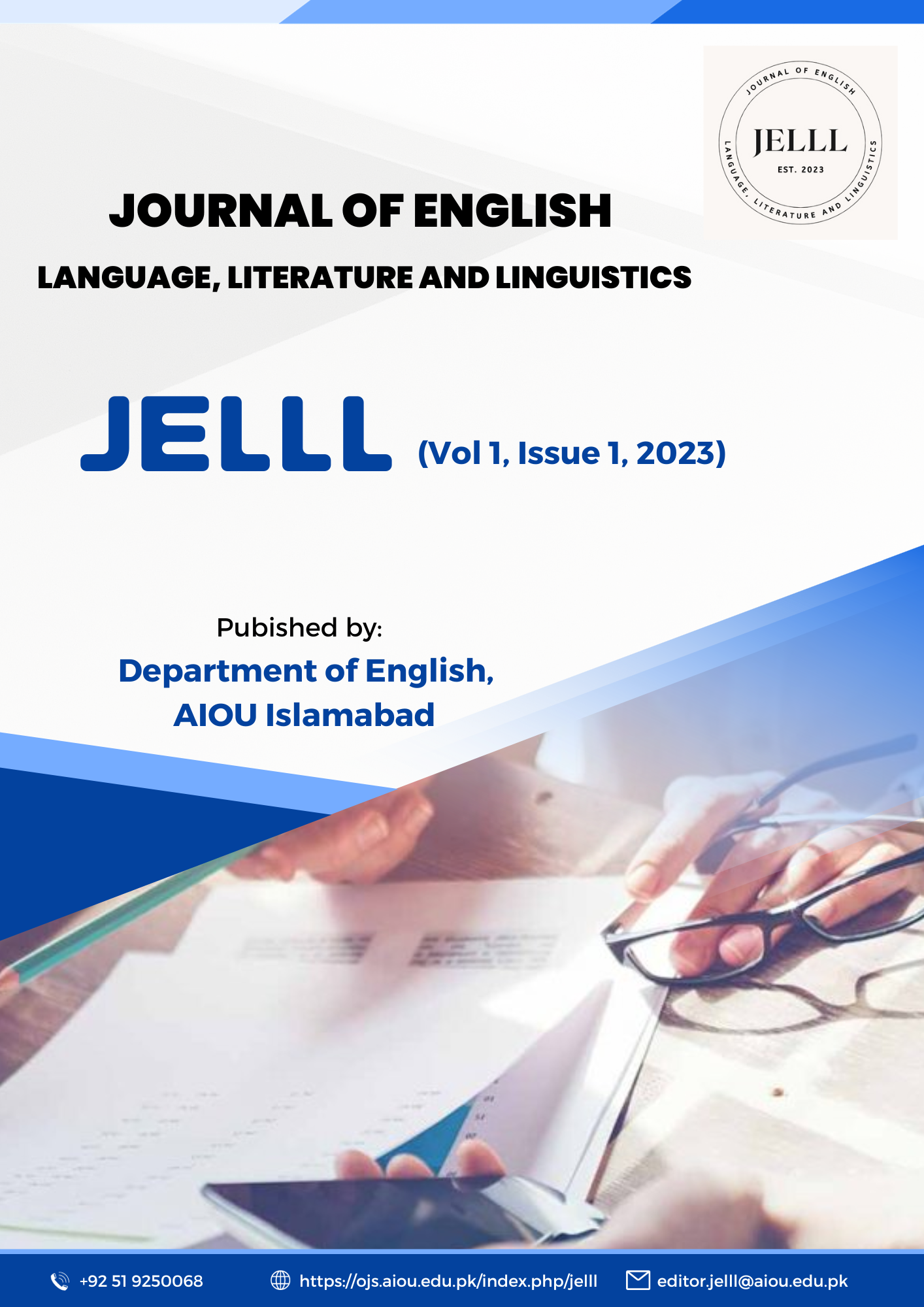Quantitative Investigation of Students' Perceptions regarding Code Switching in Pakistani English Classrooms at University Level
Keywords:
Code-switching, linguistic variety, cultural identity, language acquisition, communication, pedagogyAbstract
Code-switching is the focus of this study, illuminating its implications for communication,
cultural identity, and pedagogical methods in Pakistani English classrooms. It emphasizes the
importance of teachers recognizing and capitalizing on code-switching as a technique of
bridging language and cultural gaps for the benefit of their students' education. This study
investigates how students in Pakistani English courses feel about teachers' use of code-switching
in the class. The university students at Institute of Space and Technology Islamabad were the
population of this study. Purposive sampling technique was used for the collection of data from
the sample. For sample, 100 university students of English course were collected from the
population. Self-made questionnaire was developed for this study. The researcher collected the
data face to face through a close ended questionnaire. The collected data was analyzed through
the Statistic tool SPSS. The findings show that people see code-switching positively as a means
to improve their communication skills. Code-switching is a socio-cultural manifestation, and
respondents credit it to the preservation of their cultural identity. The results of the research
highlight the importance of educators in influencing their students' views on code-switching.
Findings show that the students feel more comfortable when they do code switching because
they can understand things easily in their language like difficult sentences, vocabulary etc. This
study has far-reaching effects on how we plan and execute instruction. The study recommends
that the student and teacher should minimize the use of code switching in class. Teacher knows
that the medium of instruction is English and they stop students to use a lot of code switching
in class. A more welcoming and culturally sensitive classroom may be created when teachers are
aware of code-switching as a communication method.
Downloads
References
Abbas, F., Aslam, S., & Khan, R. A. M. (2011). Code-mixing as a communicative strategy among the university level students in Pakistan. Language in India 11(1). 95-108.
Abbas, F., & Bidin, S. J. (2022). A critical analysis of the language planning and policy (LPP) in Pakistan and its impact on indigenous languages of Pakistan. Eurasian Journal of Applied Linguistics, 8(1), 85-96.
Abbas, F., & Iqbal, Z. (2018). Language Attitude of the Pakistani Youth towards English, Urdu and Punjabi: A Comparative Study. Pakistan Journal of Distance and Online Learning, 4(1), 199-214.
Auer, P. (1998). Code Switching in conversation: interation and identity.
Abdel Magid, M. E. M., & Mugaddam, A. H. (2013). Code Switching as an Interactive Tool in ESL Classrooms. English Linguistics Research, 2(2). https://doi.org/10.5430/elr.v2n2p3
Bullock, B. E., & Toribio, A. J. (2009). The Cambridge handbook of linguistic codeswitching. Cambridge: Cambridge University Press.
Ben Nafa, H. (2017). Joseph Gafaranga: Bilingualism as interactional practices. Multilingua, 37(1), 119–122. https://doi.org/10.1515/multi-2017-0004
Dewaele, J. M., & Wei, L. (2012). Multilingualism, empathy and multicompetence. International Journal of Multilingualism, 9(4), 352–366. https://doi.org/10.1080/14790718.2012.714380
Engku Ibrahim, E. H., Ahamad Shah, M. I., & Armia, N. T. (2013). Code-switching in english as a foreign language classroom: Teachers’ attitudes. English Language Teaching, 6(7), 139–150. https://doi.org/10.5539/elt.v6n7p139
Garcia, M. (2017). Embracing code-switching in the ESL classroom: A pedagogical perspective. Journal of Language Education, 42(3), 215-230.
Heller, M. (1988). Codeswitching: Anthropological and Sociolinguistic Perspectives. Berlin, New York: De Gruyter Mouton. https://doi.org/10.1515/9783110849615
Hernandez, A. (2020). The socio-cultural implications of code-switching among ESL students. International Journal of Multilingualism, 15(2), 145-162.
Musyken, P. (1995). Code-switching and grammatical theory. In Milroy, L., & Musyken, P. (Eds.),One speaker, two languages; cross disciplinary perspectives on code-switching (pp. 177-198). Cambridge: Cambridge University Press. http://dx.doi.org/10.1017/CBO9780511620867.009
Milroy, L., & Musyken, P. (1995). Introduction: code-switching and bilingualism research. In Milroy, L., & Musyken, P. (Eds.), One speaker, two languages; cross disciplinary perspectives on code-switching (pp. 1-14). Cambridge: CambridgeUniversity Press. http://dx.doi.org/10.1017/CBO9780511620867.001
Mahootian, S. (2006). Code switching and mixing. In K. Brown (Ed.), Encyclopedia of Language & Linguistics (Vol. 2, pp. 511-527). Oxford: Elsevier.
Moro, C. (2015). Volume 43 (Vol. 2011, Issue 650).
Rahman, T. ( 1997). Language and Politics in Pakistan. Oxford University Press .
Rahman, T. (1999). Language, Education, and Culture. Oxford University Press.
Rodriguez, J. (2019). Cognitive aspects of code-switching in second language acquisition. Applied Linguistics, 36(4), 421-438.
Smith, L. (2018). Code-switching as a cognitive tool in the language development of ESL students. Language Learning, 68(1), 98-115.
Lachmy Narayana, J., & Nur Syuhada, M. R. (2018). Code switching as a learning strategy in polytechnic ESL classroom: Exploring perceived functions and lecturers-students’ attitudes. International Journal of Education, Psychology and Counseling, 3(12), 23–36. www.ijepc.com
Lee, S. (2021). Code-switching and its impact on confidence and motivation in ESL learners. TESOL Quarterly, 55(1), 78-95.
Vallejo, C. (2018). Translanguaging: Language, Bilingualism and Education, by Ofelia García and Li Wei. Bellaterra Journal of Teaching & Learning Language & Literature, 11(1), 85–95. https://doi.org/10.5565/rev/jtl3.764
Wei, L. (2018). Translanguaging as a Practical Theory of Language. Applied Linguistics, 39(2), 261–261. https://doi.org/10.1093/applin/amx044
Downloads
Published
How to Cite
Issue
Section
License
Authors shall retain the copyrights to the article. Author/s grant the journal an irrevocable,
non-exclusive license to publish the article electronically and in print format, and to identify
itself as the original publisher. Author(s) can grant any third party the right to use the article
freely as long as its original authors and citation details are identified. The article is
distributed under the Creative Commons Attribution 4.0 License. Unless otherwise stated,
associated published material shall be distributed under the same license.


